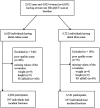Fracture risk based on high-resolution peripheral quantitative computed tomography measures does not vary with age in older adults-the bone microarchitecture international consortium prospective cohort study
- PMID: 38477737
- PMCID: PMC11205894
- DOI: 10.1093/jbmr/zjae033
Fracture risk based on high-resolution peripheral quantitative computed tomography measures does not vary with age in older adults-the bone microarchitecture international consortium prospective cohort study
Abstract
Fracture risk increases with lower areal bone mineral density (aBMD); however, aBMD-related estimate of risk may decrease with age. This may depend on technical limitations of 2-dimensional (2D) dual energy X-ray absorptiometry (DXA) which are reduced with 3D high-resolution peripheral quantitative computed tomography (HR-pQCT). Our aim was to examine whether the predictive utility of HR-pQCT measures with fracture varies with age. We analyzed associations of HR-pQCT measures at the distal radius and distal tibia with two outcomes: incident fractures and major osteoporotic fractures. We censored follow-up time at first fracture, death, last contact or 8 years after baseline. We estimated hazard ratios (HR) and 95%CI for the association between bone traits and fracture incidence across age quintiles. Among 6835 men and women (ages 40-96) with at least one valid baseline HR-pQCT scan who were followed prospectively for a median of 48.3 months, 681 sustained fractures. After adjustment for confounders, bone parameters at both the radius and tibia were associated with higher fracture risk. The estimated HRs for fracture did not vary significantly across age quintiles for any HR-pQCT parameter measured at either the radius or tibia. In this large cohort, the homogeneity of the associations between the HR-pQCT measures and fracture risk across age groups persisted for all fractures and for major osteoporotic fractures. The patterns were similar regardless of the HR-pQCT measure, the type of fracture, or the statistical models. The stability of the associations between HR-pQCT measures and fracture over a broad age range shows that bone deficits or low volumetric density remain major determinants of fracture risk regardless of age group. The lower risk for fractures across measures of aBMD in older adults in other studies may be related to factors which interfere with DXA but not with HR-pQCT measures.
Keywords: cohort study; fracture risk; high resolution peripheral quantitative computed tomography; osteoporosis.
© The Author(s) 2024. Published by Oxford University Press on behalf of the American Society for Bone and Mineral Research. All rights reserved. For permissions, please email: journals.permissions@oup.com.
Conflict of interest statement
None declared.
Figures
Similar articles
-
Short-term risk of fracture is increased by deficits in cortical and trabecular bone microarchitecture independent of DXA BMD and FRAX: Bone Microarchitecture International Consortium (BoMIC) prospective cohorts.J Bone Miner Res. 2024 Oct 29;39(11):1574-1583. doi: 10.1093/jbmr/zjae143. J Bone Miner Res. 2024. PMID: 39236248
-
Rapid Cortical Bone Loss at the Distal Radius Is Associated With Higher Risk of Fracture in Older Men - The STRAMBO Study.J Bone Miner Res. 2023 Jun;38(6):841-850. doi: 10.1002/jbmr.4811. Epub 2023 Apr 24. J Bone Miner Res. 2023. PMID: 36987872
-
Women with previous fragility fractures can be classified based on bone microarchitecture and finite element analysis measured with HR-pQCT.Osteoporos Int. 2013 May;24(5):1733-40. doi: 10.1007/s00198-012-2160-1. Epub 2012 Nov 20. Osteoporos Int. 2013. PMID: 23179565
-
Best Performance Parameters of HR-pQCT to Predict Fragility Fracture: Systematic Review and Meta-Analysis.J Bone Miner Res. 2021 Dec;36(12):2381-2398. doi: 10.1002/jbmr.4449. Epub 2021 Oct 18. J Bone Miner Res. 2021. PMID: 34585784 Free PMC article.
-
High-resolution imaging of bone and joint architecture in rheumatoid arthritis.Br Med Bull. 2014 Dec;112(1):107-18. doi: 10.1093/bmb/ldu033. Epub 2014 Nov 17. Br Med Bull. 2014. PMID: 25403741 Review.
Cited by
-
Biomechanics of a Drop Landing: Osteogenic Stimulus Measures May Vary.J Musculoskelet Neuronal Interact. 2025 Mar 1;25(1):1-17. doi: 10.22540/JMNI-25-001. J Musculoskelet Neuronal Interact. 2025. PMID: 40024223 Free PMC article.
-
Bone stiffness and strength at the distal radius can be determined using photon-counting CT.Arch Osteoporos. 2025 Mar 21;20(1):40. doi: 10.1007/s11657-025-01527-2. Arch Osteoporos. 2025. PMID: 40116966
References
Publication types
MeSH terms
Grants and funding
- 50564/Hospices Civils de Lyon
- Merck Sharp & Dohme
- R01AR061445/National Institute of Arthritis Musculoskeletal and Skin Diseases of the National Institutes of Health
- R01 AG065299/AG/NIA NIH HHS/United States
- E1482.042/Abondement ANVAR
- HHSN268201500001I/HL/NHLBI NIH HHS/United States
- Geneva University Hospitals & Faculty of Medicine Clinical Research Centre
- Geneva University Hospitals Private Foundation
- HHSN268201500001C/HL/NHLBI NIH HHS/United States
- ANR-07-PHYSIO-023/Agence Nationale de la Recherche
- Amgen Inc
- N01-HC-25195/National Heart, Lung, and Blood Institute Framingham Heart Study
- R01 AR027065/AR/NIAMS NIH HHS/United States
- CIHR 158975/CAPMC/ CIHR/Canada


